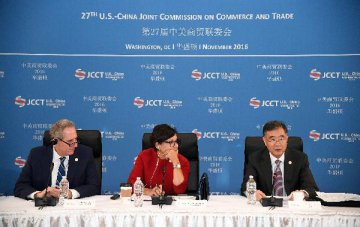
The Economic Information Daily learned that the digital economy has risen to a national strategy. It has also become an important engine for China's economic growth as well as a major breakthrough for the country’s industrial transformation and upgrading. As of now, many provinces have issued plans for the development of the digital economy, and set goals for the total size of the digital economy or its proportion in GDP, aiming to promote local economic growth with the digital economy as a support. The recent State Council executive meeting also proposed to promote industrial upgrading. The meeting made it clear that China will prepare and issue outline for the development strategy for the digital economy.
China's digital economy has now entered a period of rapid development. China Academy of Information and Communications Technology (CAICT) issued the white paper on the development of digital economy in China 2017 at the recent China Internet Conference. It is noted that in 2016, China's digital economy reached a size of 22.6 trillion yuan, an increase of 18.9 percent year on year, accounting for 30 percent of the GDP. In 2016, China's digital economy's contribution to GDP has reached 69.9 percent.
The China digital economy index in the white paper also shows that China’s digital economy expands much faster than the country’s macro-economy, and has become an important driver for economic growth. It is estimated that China's digital economy will exceed 32 trillion yuan in 2020, accounting for 35 percent of the GPD. In 2030, its proportion in GDP will exceed 50 percent. China will enter an era of digital economy.
In fact, the digital economy has become a major development strategy for both the state government and local government. In the state level, at the G20 Hangzhou summit, China, as the G20 presidency, made digital economy for the first time a major issue in the innovation and growth blueprint of the G20 countries. China’s 13th Five-Year Plan for the application of information technology also requires that by 2020, China should achieve remarkable results in digital economy. This year’s government work report also for the first time mentioned the digital economy. It proposed to promote the in-depth development of the “Internet plus” initiative and accelerate the development of digital economy in 2017. The recent State Council executive meeting also made it clear that China will prepare and issue outline for the development strategy for the digital economy.
At the local level, a number of provinces, including Guizhou, Jiangsu and Anhui, have issued plans for the development of digital economy since the beginning of this year. Guizhou Province proposed that by 2020, the added value of major industries related to the digital economy will increase by over 20 percent annually on average. The added value of digital economy will accounts for more than 30 percent of the local GDP. The digital economy will play a further leading and driving role in the development of the national economy. Jiangsu Province proposed that the total volume of the digital economy should reach 5.8 trillion yuan by the end of the Five-Year Plan period, and reach 14.5 trillion yuan in 2025 with its dominated role be established.
Digital economy has become a major breakthrough in economic restructuring and upgrading. Minister of Industry and Information Technology Miao Wei proposed at this year’s G20 Digital Ministers Meeting to promote integrated application and innovation, vigorously develop intelligent manufacturing, industrial Internet and other innovative applications, encourage the depth expansion of sharing economy and promote the application of digital technology in traditional industries.
It is worth noting that there are still weak links in the integration of digital technology and the real economy. Lu Chuncong, head of the Communications Policy and Economics Research Institute, CAICT, said that the development of digital technology in the three major industries is uneven. Digital technology is well-developed in the tertiary industry, while is underdeveloped in the primary and secondary industries.
Lu further pointed out that the current regulations on market access are not suitable for the development of digital economy. Regulators should explore and adopt a management model based on negative list, eradicate barriers among industries and regions and protect different market players to enter the marker in a legal and equal matter.
(Translated by Coral Zhong)























Latest comments